Explainer
- Explainer
- United Nations
Why can’t the world’s peacekeeper stop the fighting in Gaza and Ukraine?
Two regional conflicts are threatening global peace. Could the United Nations step in – and, if so, why hasn’t it?
After a deadly Israeli strike on a refugee camp in the Gazan city of Rafah on May 26, Turkish President Recep Tayyip Erdogan had some choice words for the organisation supposed to be the world’s peacekeeper. “I am calling out to the United Nations,” he said. “What do you even do … What are all those giant buildings for? Why bother spending that much money or employing that many people?” He concluded, somewhat dramatically: “The UN, along with its spirit, has died in Gaza.”
It’s not the first time the UN, with its $5.4 billion annual budget and 37,000-odd employees, has been accused of sitting on its hands while a catastrophe unfolds. But recent events, not only in Gaza but in Ukraine and the increasingly lawless Caribbean nation of Haiti, have once again raised questions about its capabilities and relevance.
In March, the UN Security Council – the body with the jurisdiction to deploy military peacekeepers – passed a resolution demanding an immediate ceasefire in Gaza, the release of hostages and urgent humanitarian assistance for civilians. “Finally, the Security Council is shouldering its responsibility,” said the UN’s delegate for Algeria. “This bloodbath has continued for far too long.”
In April, UN Secretary-General António Guterres warned of an existential crisis. “The Middle East is on a precipice,” he said. “One miscalculation, one miscommunication, one mistake, could lead to the unthinkable: a full-scale regional conflict that would be devastating for all involved and for the rest of the world.” In May, the UN’s International Court of Justice ruled Israel must immediately halt military action in the Rafah Governorate, “which may inflict on the Palestinian group in Gaza conditions of life that could bring about its physical destruction in whole or in part”.
Yet, despite these speeches, rulings and stern admonitions, the war continues unabated: no permanent ceasefire, no mass release of hostages, and ongoing problems delivering aid. Indeed, Israeli Prime Minister Benjamin Netanyahu has vowed to fight “until the flag of victory is raised”.
What is the point of a United Nations resolution? What power does the UN have to enter a conflict like this? What is its role these days?
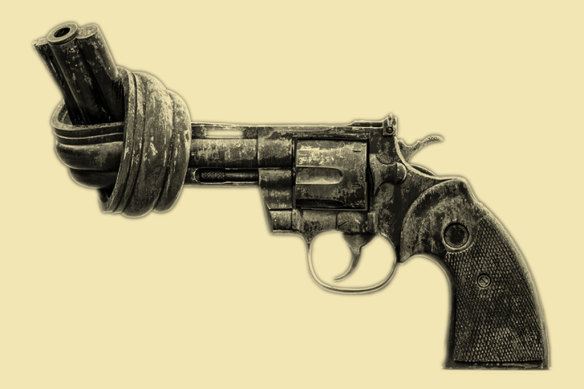
The bronze sculpture Non-Violence is displayed outside UN headquarters in New York. Made by Swedish artist Carl Reutersward in 1980 after the killing of John Lennon, who he knew, it was later bought by the government of Luxembourg which gifted it to the UN.Credit: Getty Images, digitally altered
What is the United Nations for?
It’s December 1941. The Japanese have bombed Pearl Harbour, bringing the United States into what is now a global conflict. British prime minister Winston Churchill has sailed across the Atlantic on the battleship Duke of York, risking attack by German U-boat, to meet president Franklin Roosevelt. Now a guest at the White House, Churchill has just stepped out of the bath and is towelling down when Roosevelt bursts into his bedroom. The president says he’s had an idea that can’t wait: a name for a global cooperative of countries allied against evil – the “United Nations”. Churchill, reportedly as naked and pink as a cherub, replies: “Good.”
A few days later, on New Year’s Day 1942, some 26 of the countries then at war with the Axis powers, including the US, Britain, China and the Soviet Union, agree to the “establishment of a wider and permanent system of general security” in a document that becomes known as the “Declaration by United Nations”.
Roosevelt’s brainwave aside, the UN did not come out of the blue … the League of Nations had already existed since the end of WWI. It was not particularly successful (exhibit A: World War II).
More talks follow and on June 26, 1945, 50 founding members sign the Charter of the United Nations and Statute of the International Court of Justice. The UN and its legal offsider are formally born. Today, it has grown to represent 193 member states. The only countries that aren’t members are typically those with disputed or unclear status as independent nations, such as Vatican City and Kosovo.
Roosevelt’s brainwave aside, the UN did not come out of the blue. A similarly internationalist organisation called the League of Nations had already existed since the end of WWI, charged with maintaining peace through disarmament, negotiation and arbitration, and ensuring there was never another global conflagration.
It was not particularly successful (exhibit A: World War II). At its peak, only 58 nations were members and, critically, the US never joined. Its structure was tortuous: important decisions required levels of unanimous agreement that were sometimes impossible to attain. A key philosophy called collective security required states to go to war at a moment’s notice to quash aggression, which proved unworkable in practice, such as when appeasement-era Britain chose to overlook Germany’s occupation of its neighbouring territories in the 1930s.
Yet, the League’s ideals were sound, Churchill observed in 1946. “It failed because those principles were deserted by those states which brought it into being because the governments of those states feared to face the facts and act while time remained.”
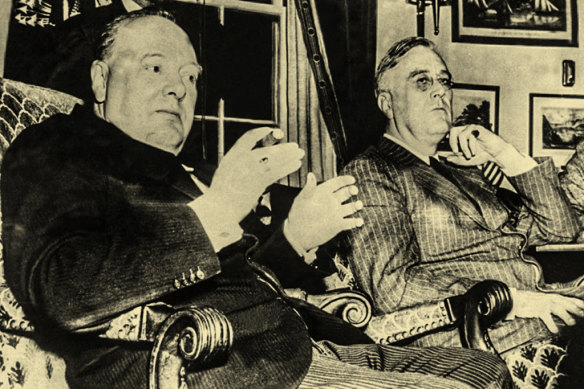
Winston Churchill and Franklin Roosevelt at the White House in 1942. Credit: Getty Images, digitally altered
The nascent United Nations offered a chance to reboot the whole idea with the same basic goals but more effective mechanisms. Its founding document runs to many pages but boils down to these key principles: saving future generations “from the scourge of war”; ensuring equal rights for all people and nations “large and small”; practising tolerance; maintaining and respecting international law; and employing “international machinery for the promotion of the economic and social advancement of all peoples”.
‘It’s adapted quite a lot over the years, building up its human rights architecture, co-ordination of humanitarian assistance and the sustainable development agenda ...’
“It was mainly set up to address international conflict,” Charles Hunt, a senior fellow at the United Nations University, tells us from New York. “Conventional warfare on a battlefield between two states over territory, and questions around disarmament. They were the big issues of the day. It’s adapted quite a lot over the years, building up its human rights architecture, co-ordination of humanitarian assistance and the sustainable development agenda, as well as the extensive infrastructure around those. It’s also increasingly sought to respond to conflict within states or civil wars in the post-Cold War era.”
Today, the UN is a vast apparatus headed by six key bodies, five of which, including the General Assembly and the UN Secretariat, are based at the iconic UN headquarters on the banks of New York’s East River (what Turkey’s Erdogan calls those “giant buildings”).
Then there are its numerous agencies, which include the International Monetary Fund, UNESCO (which, among other things, confers World Heritage Site status), the World Health Organisation and the World Bank, and countless associated deliverers of education, development, famine relief and welfare programs.
Of greatest relevance to us today are the three bodies most empowered to intervene in conflict: the General Assembly (composed of the hundreds of national representatives who meet in a vast hall), the Security Council (five permanent and 10 temporary members) and the UN’s legal arm, the International Court of Justice, headquartered in The Hague in the Netherlands (and not be confused with the International Criminal Court, or ICC, a different body that can prosecute individuals for international crimes including genocide).
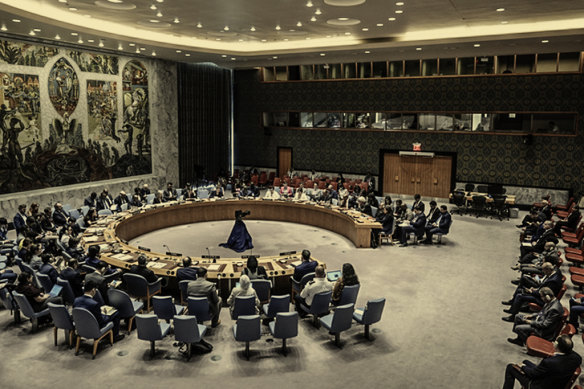
Delegates at a UN Security Council meeting about the war in Gaza on May 29. Credit: AP/Seth Wenig, digitally altered
How could the UN intervene?
The UN is not a world “super-government”. It does not have a standing army (its blue-helmeted peacekeepers have to be rustled up from member states as required) and has only rarely intervened in an ongoing conflict without the permission of the combatants (its campaign in the Korean War being a notable exception). Everything it does depends on the will of nations to agree on a course of action and to supply funding and personnel for subsequent UN missions. Australia, for example, has a history of deploying troops in their thousands to hotspots but presently has just a few dozen in the field.
Toothless and bogged down in diplomatic posturing it may sometimes appear; yet, says Hunt, it remains “perhaps the only place where great powers – those in decline, those rising, whoever it may be – can still meet to discuss the major crises facing the world”.
‘It’s an outmoded structure, and there’s a lot of talk about Security Council reform, but it’s a bit like asking the turkeys to vote for Christmas.’
Often, “the failures get highlighted rather than the successes,” says Lisa Sharland, defence policy adviser at the permanent mission of Australia to the UN from 2009 to 2014 and now a director at the Stimson Centre, a think tank in Washington DC. “I think there are very high expectations for the UN. Sometimes those expectations need to be measured in terms of what it can do, and the fact that a lot relies on countries to invest in and support it.”
Its decisions are made by discussion, resolutions and voting. In the General Assembly, each nation gets one equal vote. Leaders can make speeches, usually limited to 15 minutes, although Libyan dictator Muammar Gaddafi memorably hijacked the podium in 1990 for over an hour and a half. He complained about being jet-lagged, tore up a copy of the UN charter, demanded $12 trillion compensation for colonialism in Africa, suggested swine flu had been grown in a military laboratory as a weapon and called for an inquiry into the assassination of John F. Kennedy. (His was by no means the record; Cuban leader Fidel Castro spoke for four-and-a-half hours in 1960.)

Libyan leader Muammar Gaddafi exceeds his time limit several times over while addressing the UN General Assembly in New York in 1990.Credit: Getty Images, digitally altered
In the Security Council, the body responsible for maintaining peace and deploying peacekeepers, all 15 members can vote on resolutions but, critically, each of the five permanent members (France, Russia, China, the US and the UK; a legacy of World War II) also has the power to veto any “substantive” resolution. (The United Nations originally recognised Chiang Kai-shek’s Kuomintang government as China’s legitimate leadership, even after it departed the mainland to Taiwan in 1949. In 1971, the UN voted to recognise the People’s Republic of China, then led by Mao Zedong, instead.)
The veto provision can seem needlessly crippling but it has also been considered a necessary evil, ensuring rival superpowers have continued to show up to the negotiating table, even during the Cold War.
“When great power interests are at play,” says Hunt, “the Council structure means that it will be gridlocked. It’s an outmoded structure, and there’s a lot of talk about Security Council reform, but it’s a bit like asking the turkeys to vote for Christmas.”
Meanwhile, the General Assembly and the Security Council elect judges to the International Court of Justice, the only world body charged with adjudicating legal disputes between nations. UN members are bound to accept its rulings, but – and it’s a big but – the court has no mechanism to enforce rulings in the event they are disputed or simply ignored.
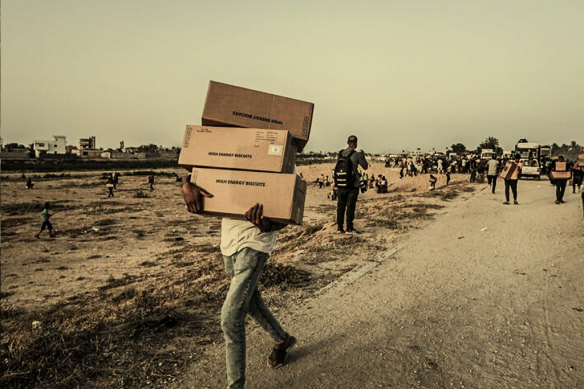
A Palestinian carries food aid boxes from the UN World Food Programme in central Gaza, on May 18. Credit: Ahmad Salem/Bloomberg, digitally tinted
What has the UN done about Gaza and Ukraine?
The UN has a long history in Palestine. In 1947, it recommended that Mandatory Palestine (a former Ottoman territory then managed by the British) be divided into Arab and Jewish states, with international status given to the city of Jerusalem. Palestinians and neighbouring Arab countries did not agree with the plan, which led to the Arab-Israeli war of 1948 and a major dislocation of between 700,000 and 800,000 Palestinian refugees, many of whom ended up in the Gaza Strip, a wedge of land between Egypt, Israel and the Mediterranean Sea.
Numerous resolutions followed over the years as the UN attempted to improve the refugees’ plight, which only worsened following the Six-Day War of 1967 when Israel occupied the Gaza Strip and the Sinai Peninsula up to the east bank of the Suez Canal.
In 1975, the UN founded an organisation pledged to “the Inalienable Rights of the Palestinian People” that was charged with helping them “return to their homes and property from which they had been displaced”. The 1980s and beyond saw multiple UN resolutions concerning living conditions and human rights of the Palestinian people, including in 1989 an expression of “profound shock” over the Israeli killing of Palestinian civilians in the militarily occupied West Bank village of Nahalin.
‘There needs to be this willingness to strike a peace agreement amongst the parties in order for peacekeeping to play its role.’
Since the war in Gaza, following the October 7 attacks by Hamas on Israeli civilians and military, the UN’s Guterres has made several demands for a ceasefire. He has condemned bloodshed on both sides, called for the release of hostages and described relief that has reached refugees as “a drop of aid in an ocean of need”. The UN agency for Palestinian refugees (UNRWA) has been attempting to provide essential services in Gaza amid what it has called “increasing challenges”, particularly in the border city of Rafah, where it says “conditions are unspeakable”. In May, the UN’s General Assembly recognised Palestine as an “observer” state and urged the Security Council to consider recommending its admission as a full UN member.
What the UN has not done, though, is to send peacekeeping troops into Gaza to stop the fighting, as some nations have demanded. Such a mission would be only “very, very, very hypothetical”, UN Under-Secretary-General for Peace Operations Jean-Pierre Lacroix said in May. He said several criteria would have to be met first: a ceasefire, an agreement from combatants to accept UN troops as referees, and a resolution to act from the UN Security Council.
“The term peacekeeping is quite important here,” says Charles Hunt, who is also professor of global security at RMIT. “There’s all sorts of different types of UN operations that are called peacekeeping or peace operations. But the fundamental premise for them is that there is a peace agreement in place or a ceasefire struck, and what is required is a security guarantee so that the parties could de-escalate, stand down and allow the political space for agreement. There needs to be this willingness to strike a peace agreement amongst the parties in order for peacekeeping to play its role.”
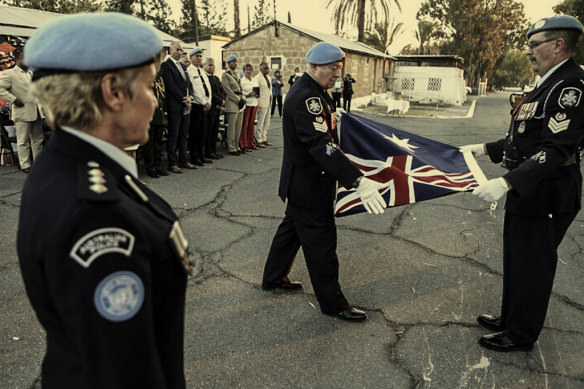
Australian UN peacekeepers during a flag-lowering ceremony ending Australia’s police officer contribution to the UN Cyprus mission in 2017. Credit: AP, digitally tinted
The UN has had some success, notably in Cyprus, where peacekeepers – including, until 2021, a contingent from Australia – have kept a lid on simmering tensions between Greek Cypriot and Turkish Cypriot communities since 1964. It maintains a large presence in several African nations, including the Democratic Republic of Congo, where it has deployed some 14,000 military personnel to, among other things, protect civilians displaced by civil conflict and support the beleaguered government.
But it is also clearly wary of rushing headlong into new conflicts. “I would say very bluntly that there are good reasons to be hesitant,” former UN peacekeeping boss Jean-Marie Guehenno told the Financial Times in 2008 after the organisation had limited success experimenting with more forceful peacekeeping missions in some parts of Africa. “There’s an overemphasis on what force can achieve. The fundamental error is to think of UN forces as if they were the world police,” he said. “The danger is that you do something, and then if you go into a failure, you compromise an instrument that could make a real difference in other places. And so you haven’t helped, really, those you meant to help, but you have done a disservice to all those where peacekeeping could make a real difference.”
The UN has made the prevention of mass atrocities a priority in recent decades, says Josie Hornung, a PhD researcher with the Asia Pacific Centre for the Responsibility to Protect at the University of Queensland. “A huge amount of work has been done on early warning and structural prevention,” she says. “But it hasn’t really translated into early action or any sort of consistent response when atrocity is imminent or ongoing.”
The 1994 Rwandan massacre – the genocide of hundreds of thousands of ethnic Tutsis by their Hutu countrymen– happened under the UN’s nose: critics say it ignored warning signs. The UN subsequently accepted it was too slow to raise an adequate peacekeeping force to intervene. A year later, in Bosnia, Serbian forces swept into what was supposed to be a UN-protected enclave in Srebrenica and massacred some 8000 Muslim men. “It was a real reckoning moment for the UN,” says Hunt.
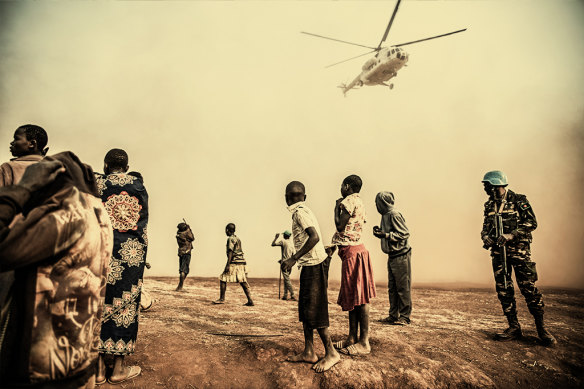
Displaced people watch a UN helicopter land with the Under-Secretary-General for Peace Operations Jean Pierre Lacroix in eastern Congo in 2022. Credit: AP, digitally altered
Somalia, 1993, started out as an aid operation but escalated into military action when the US dispatched its troops to assist with UN famine relief. A local warlord objected, shooting down two Black Hawk helicopters and killing 18 US soldiers (later chronicled in the hyperactive Ridley Scott movie Black Hawk Down). President Bill Clinton pulled the plug on the operation four days later and subsequently severely restricted the criteria under which US forces could be deployed in future UN-associated operations.
The UN has certainly trodden carefully over the current unrest in Haiti, whose police force has been overrun and outgunned by organised gangs. UN agencies have attempted to supply aid, including drinking water, and in 2023, approved deploying a force of peacekeepers to be led by 1000 Kenyan police officers. Nine months later, they have yet to arrive. Confusion over who might supply medevac helicopters is one factor, CNN has reported. In general, says Hornung, “It still remains very difficult to get states to respond to crises in which they don’t have a vested interest in the outcome.”
Any calls for specific action would always hit the brick wall of the Security Council veto.
Then there’s that (infamous) Security Council veto: getting the US, Israel’s chief supporter, to back such an action in Gaza would be unlikely. “Primarily, the US would veto it in defence of its ally [Israel],” says Hunt. “But it’s not clear that the rest of the council would think that was a good idea either. It’s not entirely clear what that would achieve in the longer term.”
The US vetoed UN Security Council resolutions calling for an immediate ceasefire in Gaza three times before itself presenting a resolution calling for an “immediate and sustained ceasefire” in Gaza ... which Russia and China then vetoed – possibly because they didn’t want to support the US.
Eventually, a much-tweaked resolution calling for a ceasefire for the month of Ramadan and the immediate release of hostages did pass the council on March 25, after the US abstained from voting (a diplomatic tool that can be used to support a resolution’s passage without being seen to actually support it). Nothing happened.
Then, in early June, the Security Council passed another, more substantive, resolution supporting a staged ceasefire plan drafted by the US. It called for an immediate ceasefire, a swap of hostages and prisoners and, once that had happened successfully, the eventual reconstruction of Gaza’s destroyed buildings and infrastructure. The task then remained, however, to get both warring sides around the negotiating table and to agree to terms.
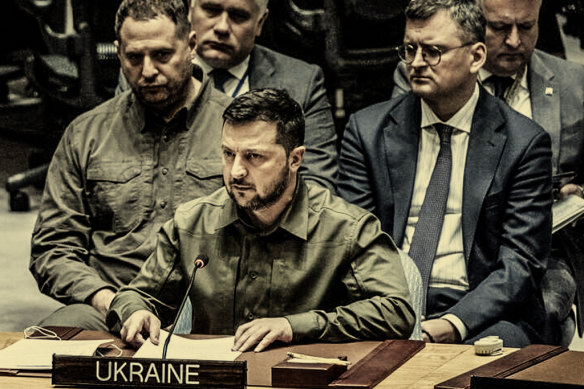
Volodymyr Zelensky implores the Security Council to take steps to halt Russia’s war against Ukraine. Credit: Fairfax
Meanwhile, in 2023, the UN hosted Ukraine President Volodymyr Zelensky, who travelled to New York to address its member nations, imploring them “to ensure that aggression against your state, if it happens, God forbid, will end not because your land will be divided, and you will be forced to submit to military or political pressure, but because your territory and sovereignty will be fully restored.”
Yet any calls for specific action would always hit the brick wall of the Security Council veto. Indeed, in September 2022, Russia had already blocked a UN call for it to “immediately, completely and unconditionally withdraw all of its military forces” from Ukrainian territory.
In one of the more bizarre episodes in UN history, Russia also took the extraordinary step of inviting former Pink Floyd frontman Roger Waters to address the Security Council in February 2023, following his controversial claim that Russia’s invasion of Ukraine had been “provoked”. Waters appeared on a large screen, accompanied by his dog, repeated his claims that “provocateurs” were responsible for the conflict and, in what was probably a surprise to the Russian delegate, called for an immediate ceasefire. The Ukrainian ambassador called Waters’ speech “another brick in the wall” of Russian disinformation.
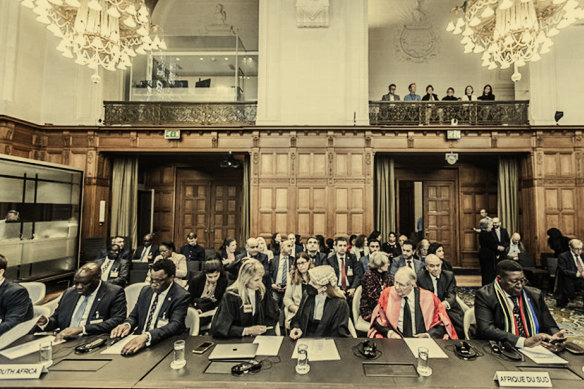
South Africa delegates are among those present in a courtroom at the International Court of Justice at The Hague in May. Credit: Getty Images, digitally altered
What about the International Court of Justice ruling?
In May, the UN’s international court made a ruling that was widely seen as an order for Israel to halt its military assault on Rafah. This was part of a still-ongoing case, brought by South Africa under the Genocide Convention, concerning alleged violations by Israel (which it denies) of its obligations in relation to Palestinians in the Gaza Strip. (South Africa’s African National Congress party has a long history of solidarity with the Palestinian cause. Any UN member state can bring a case against any other, says the UN, “when the common interest of the international community is at stake”.)
Israel argued it was already in compliance with the ruling, whose precise meaning was scrutinised by legal experts. The country “has not and will not” conduct a campaign that would destroy the Palestinian people in Gaza, said an Israeli spokesperson.
Hunt says rulings like the ICJ’s can turn up diplomatic pressure and lead to reputational damage. “And it may be that states like the US who provide military aid and weaponry to Israel may have to change their stance.” In general, notes Hornung, “ICJ rulings are binding but if they’re not complied with, they then go back to the UN Security Council, but that can be vetoed.” Yet, she says, its rulings are not without moral force. “Legitimacy is really important here. States want to be seen to be doing the right thing. Not only just to be seen to be good, but because it can affect future co-operation with other states.”
Lisa Sharland agrees. “That there’s no enforcement measures is not the only measure of relevance. There’s been a lot of media coverage of decisions made by the ICJ, which has drawn attention to the issues, what’s been taking place in Gaza and Rafah recently. That there isn’t necessarily the ability to enforce the rules doesn’t mean that the rules themselves don’t have some power in terms of the messaging that they send.”
This is a major challenge in international law, says Sharland. “It largely relies on custom, the idea that different measures of compliance are reciprocated, that you have that compliance in place, but it is largely voluntary.” Indeed, it is easy to characterise the UN as stymied by diplomatic bureaucracy, at least in terms of its role as international peacekeeper. But, as is often asked, what’s the alternative? “You cannot cure everything,” former UN special envoy Staffan de Mistura told The Economist in 2020. “Some diseases are difficult – but would you abandon the patient? You try to reduce the pain until the treatment is found.”
This Explainer has been updated to reflect events since its original publication.
Get fascinating insights and explanations on the world’s most perplexing topics. Sign up for our weekly Explainer newsletter.
Let us explain
If you'd like some expert background on an issue or a news event, drop us a line at explainers@smh.com.au or explainers@theage.com.au. Read more explainers here.